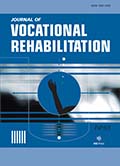Authors: Saleh, Matthew C. | Shaw, Leslie | Malzer, Valerie | Podolec, Michelle
Article Type:
Research Article
Abstract:
BACKGROUND: Interagency collaboration is one of the most highly recommended practices in transition to adulthood for youth with disabilities, but it is also one of the least empirically understood. Recent literature cites the need to clarify collaboration as a construct, and focus on collaborative practices and processes to supplement research on antecedents and outcomes. OBJECTIVES: This exploratory, mixed methods research looks to highlight collaborative practices and processes in NYS PROMISE, a statewide project aiming to improve outcomes for youth with disabilities who receive Supplemental Security Income. The project used interagency agreements to specify required service coordination processes, communications,
…information sharing, professional development, and cross-training. METHODS: The mixed methods approach combines three studies. In Study 1, the Levels of Collaboration Survey (LCS, Frey et al., 2006 ) provided data on regional network changes over time. In Study 2, an organizational attitudes and experiences (OAE) survey measured satisfaction of partner communications. In Study 3, qualitative analysis of biannual on-site interviews helped contextualize the characteristics of partnerships that project staff found effective. RESULTS: In a descriptive sense, the LCS showed increases in regional cohesion, peaking in the project’s penultimate year. Changes were statistically significant in at least one region. OAE responses showed regional increases in satisfaction with partner communications. Qualitative analysis indicated that characteristics of partnerships described as effective included: (a) joint objectives and clearly defined roles; (b) extensive sharing of information and resources; and (c) frequent communication (formal and informal). Staff turnover, inadequate organizational capacity, and partners not executing key functions were described as barriers to productive collaboration. CONCLUSIONS: Feedback from project staff provides clarification of the experiences of agency staff coordinating services, and helps refine certain constructs and assumptions common in collaboration research about transition. The authors discuss implications for future research and the development of sustainable systems of interagency collaboration in the field of transition.
Show more
Keywords: Transition to adulthood, interagency collaboration, service coordination, transition planning, youth with disabilities, Supplemental Security Income, PROMISE
DOI: 10.3233/JVR-191037
Citation: Journal of Vocational Rehabilitation,
vol. 51, no. 2, pp. 183-198, 2019





